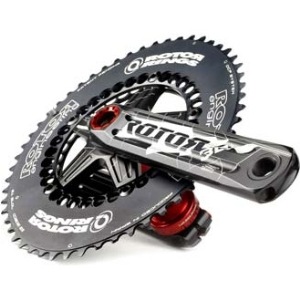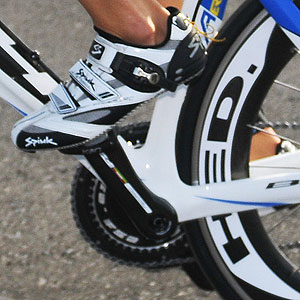Crank Length and Gearing
Despite volumes written on the subject, crank length remains a heated topic and common debate. Some say that shorter cranks are better; some say that longer cranks are better. Some define ‘short’ as 170mm, while others don’t call it short unless it’s 150mm or below. World championships have been won in all disciplines of cycling on a wide variety or crank lengths, almost regardless of a person’s height or inseam.
What is the right answer?
To get yourself primed for this article, you may want to check out this article that is specific to crank lengths for triathlon, and this article which catalogs many modern options in short cranks.
Today, we’d like to take the discussion to a place that appears to rarely get any attention, yet carries significant implications for any crank length that you choose to ride.
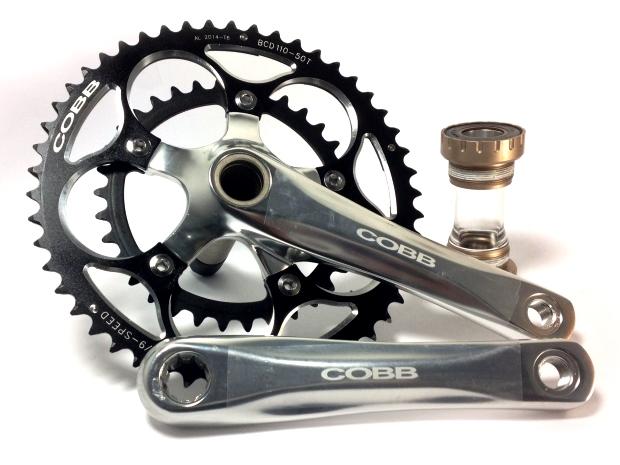
Crank Length and Gearing
Many folks are unaware that your bike’s crank length has a significant effect on its overall gearing.
You may remember that ProTour cyclist and Armstrong arch-rival, Jan Ullrich, would ride a slightly longer crankarm length for mountain stages. The idea was simple: You get more mechanical advantage with a longer crankarm for a given gear. Another way to think about it is this: The gearing is lower with the longer arm, so it is easier to push. For a given set of chainrings and rear cogset, the bike’s top gear is higher. Likewise, the lowest gear in the cassette is slightly lower.
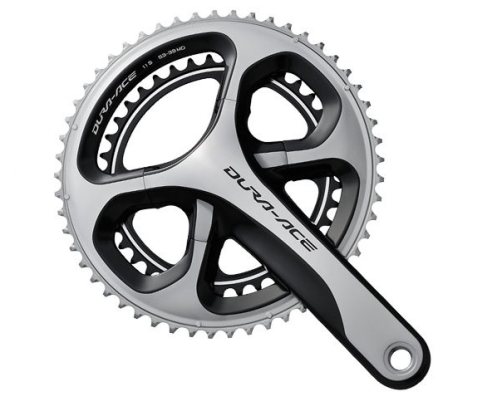
The problem we have today is that many triathletes seem to forget that ‘small’ detail – that crank length affects gearing. Short cranks are all the rage, and for many good reasons. They are not for everyone, but their popularity is growing steadily.
To find out exactly how much your gearing is affected, I highly suggest you visit Sheldon Brown’s Online Gear Calculator:
http://sheldonbrown.com/gears
If you’re not familiar with Brown, he is one of the most important and respected men in the history of bicycles. His articles are worth your time to read, and are a large part of what got me personally interested in bicycles. He passed away tragically in 2008 – an enormous loss to the cycling community.
You see, Brown understood that existing gear calculation systems were missing something very important. That something is crank length. Because of this void, he took it upon himself to create a new system – a new unit – for gearing, which considered crank length. It’s called the Gain Ratio.
To quote Brown,
“What About Crank Length? All of these systems share a common inadequacy: none of them takes crank length into account! The fact is that a mountain bike with a 46/16 has the same gear as a road bike with a 53/19 only if they have the same length cranks. If the mountain bike has 175's and the road bike 170's, the gear on the mountain bike is really about 3% lower!
I would like to propose a new system, which does take crank length into account. This system is independent of units, being expressed as a pure ratio.
This ratio would be calculated as follows: divide the wheel radius by the crank length; this will yield a single radius ratio applicable to all of the gears of a given bike. The individual gear ratios are calculated as with gear inches, using this radius ratio instead of the wheel size.
An Example:
A road bike with 170 mm cranks: (The usual generic diameter value for road wheels is 680 mm, so the radius would be 340 mm.)
340 mm / 170 mm = 2.0. (The radius ratio)
2.0 X 53 / 19 = 5.58
This number is a pure ratio; the units cancel out. I call this a ‘gain ratio’ (with thanks to Osman Isvan for suggesting this term.) What it means is that for every inch, or kilometer, or furlong the pedal travels in its orbit around the bottom bracket, the bicycle will travel 5.58 inches, or kilometers, or furlongs.”
Modern Examples
For those not excited by math and calculations, I’ll lay out an example. Let’s pretend that both your road and triathlon bikes currently have 170mm cranks, 53/39 chainrings, and 11-23 cassettes. You’re considering a change to short cranks on the tri bike, and would like to maintain the same gearing.
The chart below shows your gearing for 170, 165, and 160mm lengths. Using Brown’s gear calculator, I got as close as possible to the baseline 170mm 53/39 numbers by manipulating the chainring sizes. NOTE: The key numbers are the highest gear and lowest gear. In-between you will see some variation between the three setups, and this is inevitable. We are focusing on the highest and lowest gear that you want for your geography and fitness.

As you can see, the 165mm cranks require 52/38 rings, and the 160mm cranks require 50/36. If you want to get crazy and try a 150mm crank…
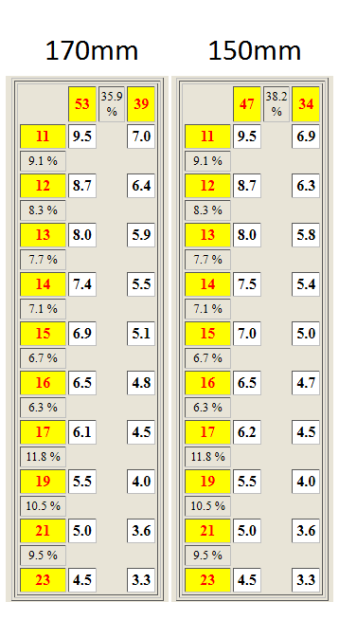
What the…? A 47/34 chainring combination? Does anyone even make that?
Therein lies part of the problem. There are not enough chainring sizes to accommodate all of the crank lengths. Some crank length changes require odd chainring sizes, such as 37, 40, and 41-tooth sizes. They can sometimes be found from smaller manufacturers, but none of the biggest component manufacturers make them. Additionally, if you normally run a 34-tooth small chainring on your 170mm cranks, you’re just not going to find many options below that. A triple-chainring setup is your best choice, but the crank length options are limited, as triples have been deemed ‘dorky’ by modern cycling. I say: Dork-it-up and do what is best for you.
The other option you have at your disposal is to manipulate your cassette size to accommodate the crank length change. Starting once again from our 170mm 53/39 standard, let’s see how much we should change the cassette:
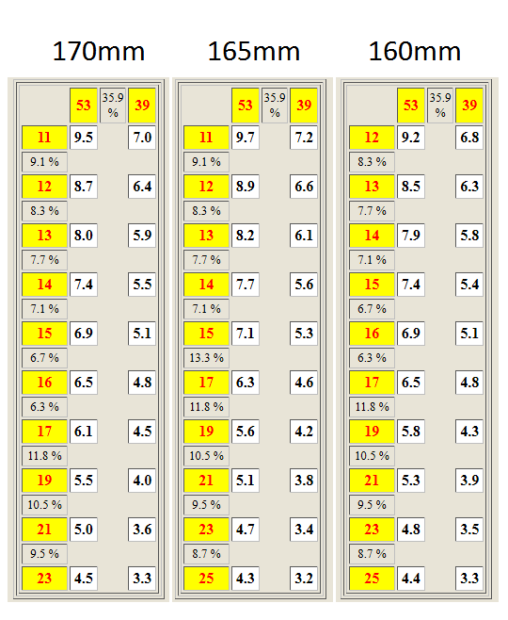
The closest we can get to our original gearing with the 165mm crank is with an 11-25 cassette, or a 12-25 for the 160mm crank. It’s not perfect; changes in cassette size have a larger overall impact on gearing. Those who normally run a compact 50/34 ring set on their ‘standard’ 170-175mm cranks must rely on wide range cassettes (11-28, 11-32) to make any substantial dent in their gearing, if they wish to make a change to a much shorter crank.
If you want to find out what chainring or cassette changes might be necessary to accommodate a change in crank length, I encourage you to use Brown’s wonderful gear calculator. Let’s also not forget about wheel size, which also has a significant effect on gearing (smaller wheels need larger chainrings to get the gearing back to ‘normal’).
What about hip angle and power output?
I have seen and heard arguments from some folks suggesting that you should maintain ring size as you change to shorter cranks, or even that you should consider going to larger rings. As we see from the discussion above, this seems to be the opposite of what we’d want.
Their reasoning is along these lines: Going to a shorter crank on a triathlon bike opens up the hip angle, which can result in improved power output. Therefore, you need a larger chainring.
My take? Yes-and-no. I argue that if a person uses 170mm arms on both their road and triathlon bikes, they are simply removing all or some of the power disadvantage by swapping to a shorter crank on the tri bike. Perhaps a 165mm arm is enough to get their Functional Threshold Power (FTP) on their tri bike back to the level that they have on the road bike. There are obviously many things that go in to this, so please bear with my simplified example.
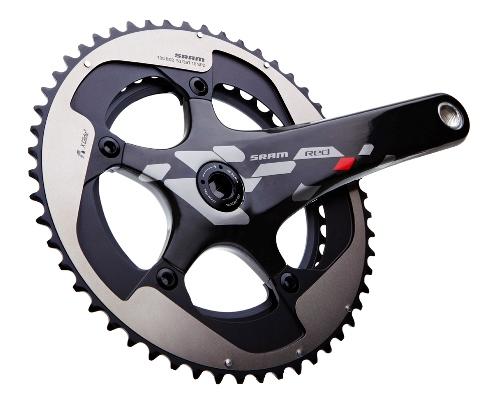
My point is that it would be a rare occurrence that a short crank choice on a triathlon bike would automatically ‘gift’ an athlete much more power than they would otherwise have. It’s about limiting losses, not magically gaining anything extra. It’s about getting that hip angle back to our ‘normal’ level.
If a rider uses 170mm cranks with 53/39 rings on their road bike, perhaps it makes sense to just stay with that same 53/39 size for their triathlon bike (and 165mm cranks). A 5mm change in arm length just isn’t that much, and the effect on gearing is rather minimal. Their tri bike will effectively have slightly taller gearing, and that’s probably fine. I would not recommend that they arbitrarily put 54/42 rings on that tri bike – further increasing the gearing – just because of their new-found gain in efficiency. They might make that choice based on a course that has a lot of tailwind, but not from the crank length itself.
Pro Athlete Examples
The reason this topic came to my attention is that Iowa-based professional triathlete, Daniel Bretscher, sent an email to me with related questions. He is working with Dave Ripley and Ben Waite of 51 Speedshop, a performance consulting and bike fitting business started by Mat Steinmetz of Boulder, Colorado. They recommended that he change from 170 to 165mm cranks for the 2014 season, and he was unsure of what chainring size to ride.
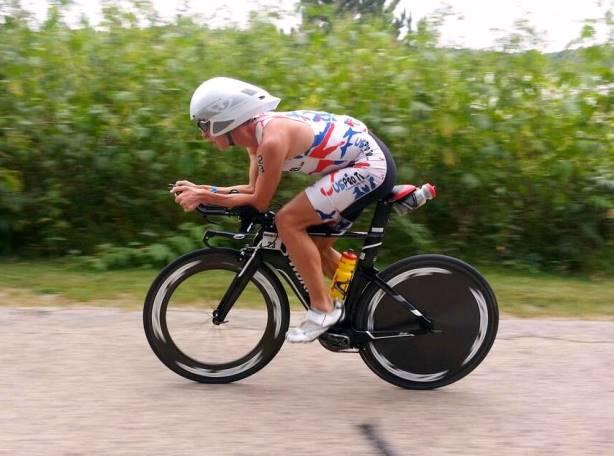
He wrote,
“This past season I felt 55/42 on 170 cranks was perfect for me. I loved having the 55 for downhills and tailwind. But 55 on 170s was definitely enough, I wouldn't want something bigger. The only instance this past season where I wanted more climbing gear than I had was during Ironman Wisconsin on 4 steep uphills. I rode an 11 x 28 cassette, and while in my 42 x 28 [gear] I couldn't produce less than about 310 watts in a few instances… though that only lasted a few seconds, and I don't think hurt me at all in the end.”
Given this example, I agreed that he definitely did not want to go to a larger ring on his 165mm crank. To maintain his exact gearing, Daniel would need 54/41 chainrings. The 54 is doable, as several manufacturers make this choice. His problem is the 41. The only 41-tooth ring that I’m personally aware of is an oval Rotor Q-ring made for 135mm BCD Campagnolo cranks – a bit of an odd duck.
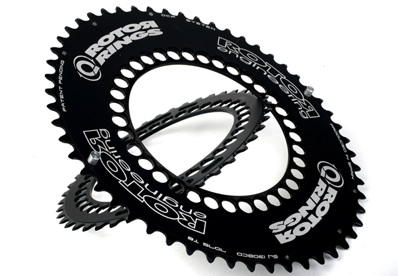
What can Daniel do? In this case, he’s likely stuck choosing between a smaller 39-tooth chainring or staying with his existing 42. He may suffer slightly on hilly courses such as Ironman Wisconsin, but – who knows – that downside might be negated if he is more efficient on the shorter crank.
The other example that I found interesting is the number of female professionals we saw at Kona this year riding short cranks, large rings, and 700c wheels. Put simply, a set of 55/42 chainrings on a 165mm crank is a huge gear. In fact, it is equivalent to using a 58/45 combination on 175mm cranks!
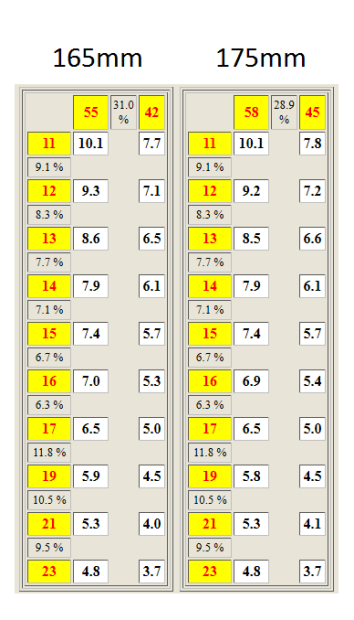
Of course, there are a lot of factors that could be playing a part in their decision for such a big gear. Kona is known for the possibility of huge tailwinds after hitting the turnaround at Hawi. It could also be that they never intend to use that 55/11 top gear, and are trying to optimize for chainline by only using the middle cassette cogs. If they were riding 650c wheels, that 55/42 and 165mm setup would be equivalent to a 51/39 on 700c wheels, a substantially shorter gear.
Summary
As you can see, there is more going on with crank length than meets the eye. For small changes in crank length, gearing is minimally affected, but anyone considering a big change (> 5mm) should take a few minutes to run a gear calculation using the tool linked above.
What size chainrings and cassette do you ride – and what crank length? Do you use the same gears on all bikes, regardless of crank length and wheel size?



